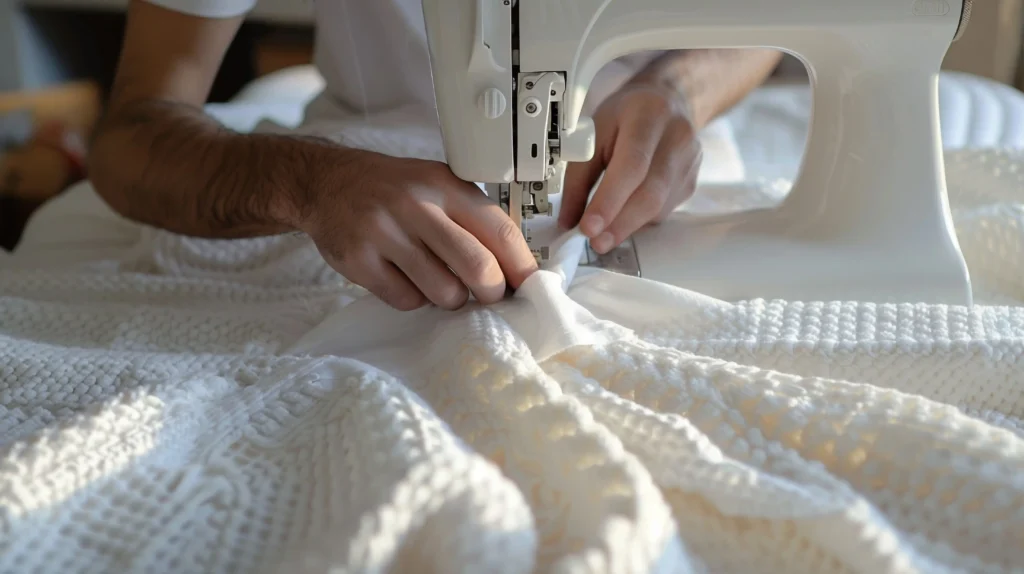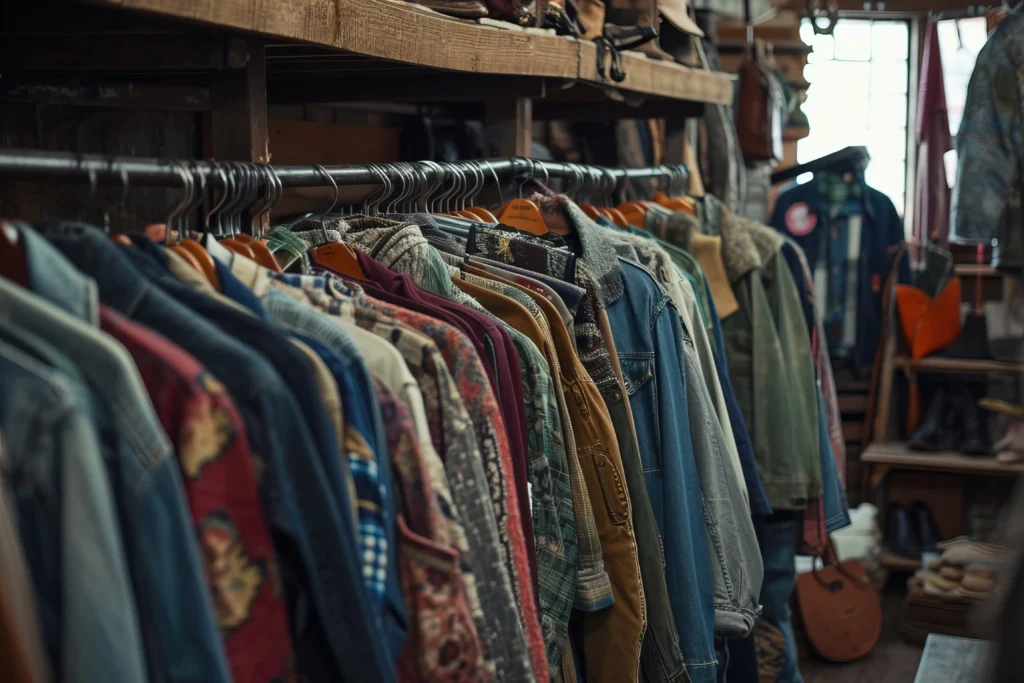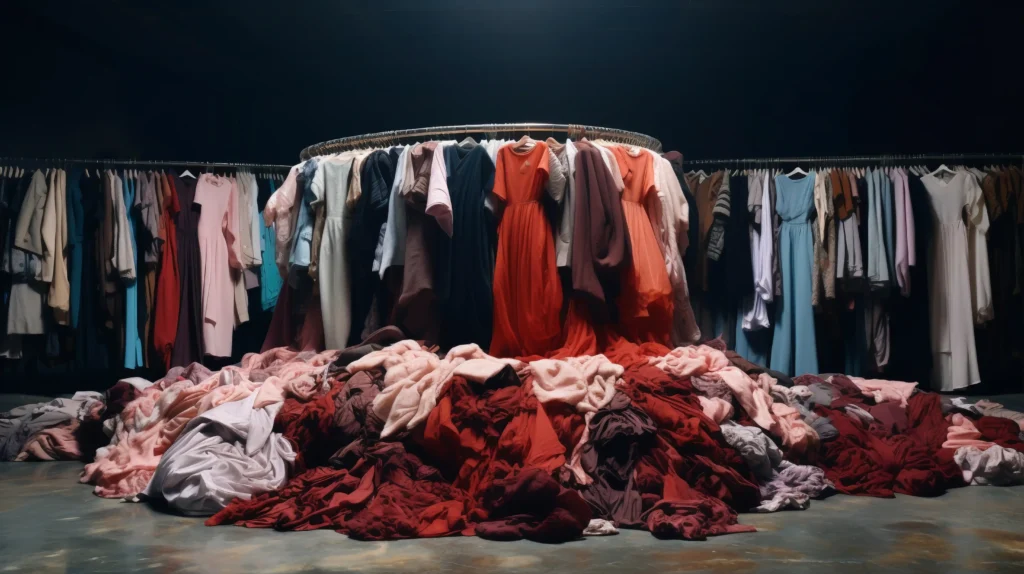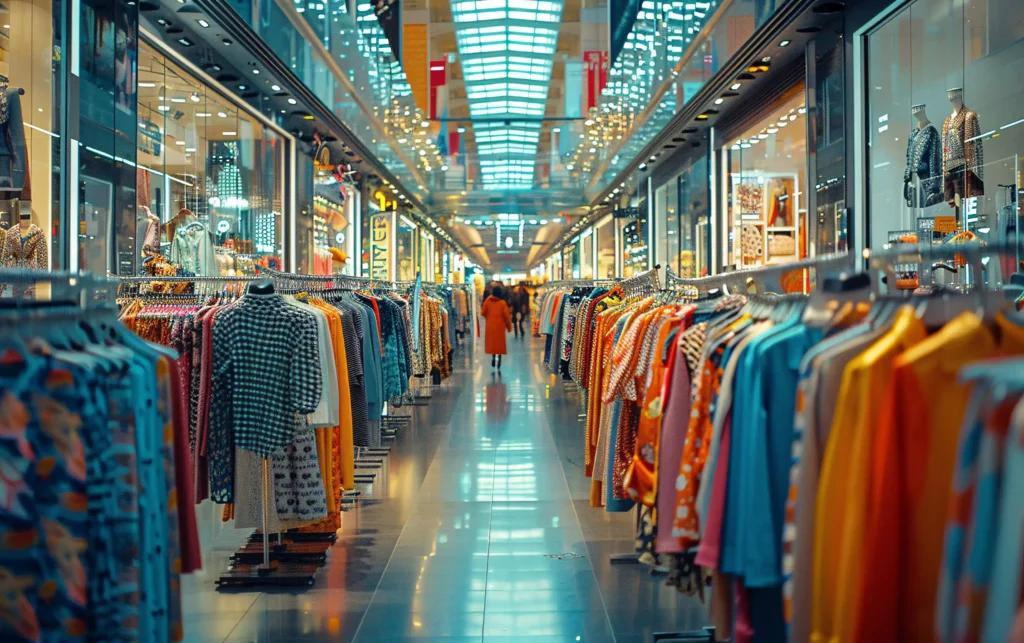Apparel garment industry growth in the US sparks many questions in 2025: How big is it? What’s driving demand? Is the ‘Made in America’ tag drawing a resurgence?
If you are launching a clothing line or trying to scale an existing brand, these answers matter. The garments industry in the USA has reached $395 billion in value and continues to grow. But behind these numbers, a more fundamental structural shift is taking place toward sustainability, digital transformation, and localized production.

Buyers want more than style. They want transparency, ethical sourcing, and quick delivery. Hence, production in the US is on the rise.
Imagine: Calling the new fashion startup in Chicago that has designed an ethical streetwear line. Instead of shipment of production offshore, the founder associates with a local manufacturer via Maker’s Row. More fashion startups have started using Maker’s Row and similar platforms to connect with manufacturers directly and thus cut down on cost and lead time.
Whether you are a designer or an investor, this blog will help you understand what is setting the trend in US fashion in 2025.
US Apparel Garment Industry: Key Statistics in 2025
Apparel garment industry leaders were rethinking strategies in 2025. Take, for example, a California-based yoga-wear brand. Being forced by shipping delays and rising costs, they could no longer allow imports, so the company had to opt for using local manufacturers instead. Through Maker’s Row, they launched an eco-friendly line with better margins and faster delivery.

This is just one example of how the garments industry in the USA is evolving. Given its current market size of over $395 billion, with steady annual growth, it does present a formidable factor in the American economy. More importantly, however, it is evolving rapidly.
Want to know Where To Find Apparel Orders? A Guide For Factories | Read this
Leaving views aside, 2025 brings new technology and buying habits with AR-based online shopping and on-demand clothing production, which are hard to remain ignored by any brand. In fact, selling sustainable clothing should not even be considered a trend; it is the minimum. And reshoring production plants is much needed in bringing agility and competitive spirit to US brands.
Here’s a snapshot of how the garments industry looks this year:
| Metric | Data (2025) |
| Total Market Size | $395 billion |
| Growth Rate | 4.6% annually |
| Employment | 582,000+ workers |
| Online Apparel Sales | 38% of total sales |
| Top Segment | Casualwear (36%) |
| Sustainable Apparel Growth | 11.3% annually |
Source: Statista, IBISWorld,McKinsey & Company
The apparel garment industry remains a major contributor to the US economy. Even post-pandemic, it continues to grow through innovation and tech adoption.
Major Trends in the Apparel Garment Industry in 2025
The apparel garment industry in 2025 is no longer what it was even five years ago. Changing consumer habits, new technology, and global pressures have reshaped how clothing is designed, produced, and sold. Below are the four biggest trends impacting the garments industry this year:
1. Sustainable Fashion
Sustainability is considered a non-negotiable. In 2025, the whole ecosystem of consumers and retailers would call for it. Today’s buyer is interested to know: how was their stitch made, on what material, and how much waste was shed in the process?

As a result, many brands now choose organic cotton, recycled polyester, and plant-based dyes. Clothing lines are using zero-waste cutting techniques and limiting water use in production. Large companies like Levi’s and Patagonia lead the movement, but even small US-based startups are following suit.
Also Explore Men’s Fashion in 2025: Trends, Essentials & 25 Style Tips
2. On-Demand Manufacturing
The traditional system offers excess inventory that either gets destroyed or is marked down to discourage further wastage. On the other hand, on-demand manufacturing intends to produce just enough inventory and exactly when needed.
This trend is growing fast in 2025, thanks to advancements in AI, automated machinery, and digital inventory tools. Instead of forecasting months in advance, brands now collect real-time data to predict demand more accurately.
3. Rise of Digital Fashion
Technology has been transforming “how the world shops for clothing.” Consumers have come to expect more than just a basic photo and product description; they want immersive and personal experiences.
In 2025, augmented reality (AR), virtual fitting rooms, and 3D product models are becoming standard. Retailers are using tools like Zeekit, DressX, and True Fit to help shoppers “try on” clothes virtually from their homes.
A recent McKinsey report showed that retailers using AR experiences saw a 25% increase in conversion rates. That’s a big win for e-commerce brands in the apparel garment industry.
Digital design tools also help brands create and sample garments without physical materials. A designer in Los Angeles can now use 3D CAD software to build an entire collection and preview fabric flow before a single thread is cut.
Digital fashion reduces cost, shortens development cycles, and creates a better customer experience.
4. Reshoring Production
In the past, many US brands relied on overseas manufacturers to lower costs. But the pandemic, shipping delays, and quality issues changed that mindset. Now, reshoring—bringing manufacturing back to the USA—is gaining momentum.

American manufacturers offer several benefits: faster lead times, better communication, higher quality, and more ethical labor standards. While costs are often higher, many brands are finding that the long-term value outweighs the price difference.
Reshoring also allows brands to respond quickly to market demand, run smaller batches, and reduce carbon footprints. These factors make it one of the most significant shifts in the 2025 garments industry.
Want to know 13 Ways to Secure Clients for Apparel Manufacturing Business? Read this blog.
Top Apparel Garment Industry Sectors in 2025
The garments industry covers many sub-sectors. Below is a breakdown:
| Sector | Share of Market |
| Casualwear | 36% |
| Sportswear | 21% |
| Formalwear | 14% |
| Intimatewear | 10% |
| Workwear & Uniforms | 9% |
| Others (Kids, Maternity, etc.) | 10% |
Casual and sportswear lead the apparel garment industry. Comfort and performance are the top drivers of demand.
US vs Global Apparel Garment Industry
The apparel garment industry in the United States operates differently from global players in many ways. While the global market continues to grow, the US is seeing unique shifts driven by innovation, consumer demand, and reshoring.
Let’s break down the comparison between the US apparel garment industry and its global counterparts:
1. Market Size and Revenue
- In 2025, the global apparel garment industry is valued at over $1.8 trillion.
- The US apparel garment industry alone accounts for $395 billion, making it one of the largest single-country markets.
Though the US is just a slice of the global market, it holds strong purchasing power. American consumers spend more per capita on clothing than many other countries.

2. Manufacturing and Labor
- The majority of the world’s production occurs in Asia, particularly in China, Bangladesh, India, and Vietnam.
- These countries rely on low-cost labor and large-scale factories to produce goods cheaply.
In contrast, the US garments industry is focused on quality, ethics, and speed. Though more expensive, US-based manufacturing is gaining ground because it allows:
- Better quality control
- Shorter lead times
- Smaller batch production
- Transparent labor practices
For example, a sportswear brand in California uses local factories to avoid overseas delays and manage production in real time.
3. Technology and Innovation
The US leads in fashion tech. American brands are early adopters of:
- AI in demand forecasting
- AR for virtual try-ons
- 3D design tools for prototyping
- Sustainable material innovation
Meanwhile, many global manufacturers still rely on manual labor and outdated equipment. However, some countries like China and South Korea are catching up by investing in smart manufacturing.
The apparel garment industry in the US is known for blending tech with design, giving it an edge in quality and consumer experience.
4. Sustainability Practices
- Ten percent of carbon emissions worldwide are attributable to the apparel industry.
- Many international factories still use harmful chemicals, excessive water, and underpaid labor.
The US is pushing for green production with:
- Recycled textiles
- Energy-efficient factories
- Locally sourced materials
- Compliance with environmental laws
Sustainable practices are becoming a selling point for American brands in 2025. A growing number of small fashion companies promote their eco-friendly values and use “Made in USA” as a trust signal.

5. Supply Chain Resilience
Global supply chains are vulnerable to delays, increased freight costs, and political instability, as the COVID-19 pandemic revealed.
Since then, many US brands have chosen domestic suppliers and nearshoring partners in Mexico or Central America. This shift has strengthened the US apparel garment industry, making it more resilient and flexible.
By contrast, brands relying on international production often face:
- Shipping delays
- Tariff hikes
- Complex logistics
The global garments industry remains cost-driven, but the US model is moving toward agility, speed, and customer satisfaction.
Quick Comparison Table
| Feature | US Apparel Garment Industry | Global Garments Industry |
| Market Size (2025) | $395 Billion | $1.8 Trillion |
| Main Focus | Quality, ethics, tech | Cost, volume, export |
| Manufacturing Locations | USA, Mexico, Central America | China, India, Vietnam, Bangladesh |
| Labor Cost | High | Low |
| Technology Use | High (AR, AI, 3D design) | Medium to low |
| Sustainability Standards | Strong | Varies by region |
| Lead Times | Short (2–4 weeks) | Long (6–12 weeks) |
| Supply Chain Flexibility | High | Medium to low |
In summary, the US apparel garment industry is evolving fast to match consumer expectations and business needs. While global production still dominates in volume, the US is catching up in value, efficiency, and innovation. The shift toward local sourcing, ethical labor, and fashion technology makes the US model stand out in 2025.
How Maker’s Row Supports the Apparel Garment Industry in the USA
In 2025, finding trustworthy and ethical manufacturers is one of the largest issues in the apparel garment industry. That’s where Maker’s Row comes in.
Maker’s Row is a reliable platform to link fashion companies with more than 10,000 vetted US-based manufacturers. Whether you’re a small company designing your first collection or a large brand making the switch to local production, Maker’s Row assists you in locating collaborators for design, prototyping, pattern making, and full-size manufacturing.
Suppose you’re introducing a sustainable denim collection. Rather than spending hours scouring for responsible cut-and-sew factories, you can use Maker’s Row to sort factories by location, specialty, and scale of production. Several companies have cut time-to-market by 30–40% using this platform.
What differentiates Maker’s Row from others is that it extends its support from sourcing. It also provides tools, guides, and mentorship programs to enable small brands to develop within the cutthroat garments business. Through the emphasis on transparency, quality, and access, Maker’s Row is instrumental in redefining the US apparel garment business positively.
If you want to build locally, responsibly, and efficiently, Maker’s Row is the perfect starting point.
Role of Small Businesses in the Garments Industry
Small businesses are the backbone of the apparel garment industry in the United States. In 2025, they make up nearly 40% of the market, playing a vital role in job creation, innovation, and local economic growth.

Small fashion brands are frequently more customer-focused and nimble than big fashion corporations. They are quick to adapt to trends, test new ideas, and respond to consumer feedback. Whether it’s custom streetwear, sustainable kids’ clothing, or luxury activewear, niche brands are carving out loyal audiences.
But starting a fashion brand used to be expensive and complicated. Entrepreneurs needed large minimum orders, industry contacts, and manufacturing experience. Now, things have changed.
Thanks to digital platforms and tools, anyone can launch a brand from home with the right guidance. You no longer need to rent an office or hire a large team. With a strong idea and online presence, you can build a product, sell it directly to customers, and scale.
This is where Maker’s Row becomes incredibly valuable. It helps small fashion businesses find the right manufacturers, designers, and product developers within the USA. Whether you’re producing 50 jackets or 500 hoodies, Maker’s Row connects you with partners who can work at small and flexible volumes.
Take the example of a solo founder in Denver who used Maker’s Row to develop a line of eco-friendly loungewear. She found a pattern maker in New York, a sustainable textile source in California, and a cut-and-sew shop in North Carolina—all without leaving her home.
These kinds of success stories are growing. More small brands are choosing to build locally, sustainably, and digitally, reshaping the future of the garments industry.
In short, small businesses are not just part of the industry—they are driving many of the trends we see today. Their creativity, commitment to quality, and use of modern tools are pushing the entire apparel garment industry forward in 2025.
Online Apparel Shopping in 2025
Online shopping continues to grow. Here’s how the apparel garment industry is shifting online:
- 38% of total apparel sales are online.
- Mobile shopping makes up 64% of that.
- AR try-ons have increased conversion rates by 25%.
- Personalized recommendations drive 40% of online sales.
This digital shift is reshaping the garments industry. Fast shipping, easy returns, and interactive stores are now essential.
Challenges Facing the Apparel Garment Industry
Despite growth, the apparel garment industry faces key challenges:
- Labor shortages in manufacturing hubs.
- Supply chain delays from raw material sourcing.
- Rising costs of fabrics and logistics.
- Consumer demand for eco-friendly practices.
Brands must adapt fast to remain competitive in this evolving garments industry.
FAQs: Apparel Garment Industry USA
- What is the current size of the apparel garment industry in the USA?
As of 2025, the US apparel garment industry is valued at around $395 billion. It includes manufacturing, retail, and e-commerce operations. The industry is growing due to demand for local production, sustainability, and tech-driven fashion.
- How many people work in the US garments industry?
The garments industry in the United States will employ more than 1.1 million people in 2025. This includes factory workers, designers, product developers, e-commerce sellers, and retail staff.
- What is driving growth in the apparel garment industry in 2025?
Several factors are fueling growth:
- Sustainable fashion demand
- On-demand manufacturing
- Digital fashion tools like AR and 3D design
- Reshoring of production to the USA
- The rise of small fashion brands and direct-to-consumer models
- What are the biggest challenges in the garments industry?
The biggest challenges include:
- High manufacturing costs in the US
- Supply chain disruptions
- Fast-changing consumer trends
- Inventory management
- Competition from overseas mass production
- How is technology changing the apparel garment industry?
Technology is transforming every stage of fashion production. Factories use AI to forecast demand, brands offer virtual try-ons, and 3D design speeds up prototyping. These tools reduce waste and improve customer experience.
- Can small businesses compete in the garments industry?
Yes. In fact, small businesses make up 40% of the US apparel garment industry. With platforms like Maker’s Row, small brands now access tools, manufacturers, and services that were once only available to big corporations.
- What types of apparel are most popular in 2025?
In 2025, the most in-demand products include:
- Athleisure and activewear
- Eco-friendly basics
- Customized streetwear
- Comfort-first loungewear
- Functional fashion with tech elements
- Is US-based manufacturing growing?
Yes. Many brands are bringing production back to the USA. This trend—called reshoring—helps improve product quality, reduce lead times, and meet ethical standards. It’s a key driver in the modern apparel garment industry.
- How does Maker’s Row help in starting a fashion brand?
Maker’s Row connects startups and small businesses with vetted US manufacturers, designers, and suppliers. It simplifies sourcing, lowers the entry barrier, and speeds up development for brands in the garments industry.
- What are the sustainability trends in the apparel garment industry?
Top trends include:
- Recycled materials
- Zero-waste cutting techniques
- Biodegradable fabrics
- Ethical labor sourcing
- Eco-friendly packaging
These practices are essential for future-ready brands in the garments industry.
Final Thoughts
The apparel garment industry in the USA is growing strong in 2025. From eco-fashion to digital production, this sector is full of innovation.
Whether you’re a startup or a big brand, now is the time to tap into the garments industry opportunities. Use platforms like Maker’s Row to connect with expert manufacturers and take your brand to the next level.